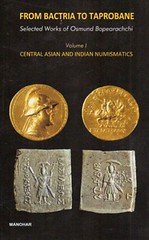
About UsThe Numismatic Bibliomania Society is a non-profit organization devoted to the study and enjoyment of numismatic literature. For more information please see our web site at coinbooks.org SubscriptionsThose wishing to become new E-Sylum subscribers (or wishing to Unsubscribe) can go to the following web page link MembershipThere is a membership application available on the web site Membership Application To join, print the application and return it with your check to the address printed on the application. Membership is only $20 to addresses in the U.S., $25 for First Class mail, and $30 elsewhere. For those without web access, write to: David M. Sundman, Treasurer
AsylumFor Asylum mailing address changes and other membership questions, contact David at this email address: dsundman@LittletonCoin.com SubmissionsTo submit items for publication in The E-Sylum, just Reply to this message, or write to the Editor at this address: whomren@gmail.com BUY THE BOOK BEFORE THE COINSale Calendar |
- WAYNE'S WORDS: THE E-SYLUM MAY 3, 2015
- KOLBE & FANNING UPDATE NUMISLIT.COM WEB SITE
- NEW BOOK: BENJAMIN FRANKLIN IN TERRA COTTA
- NEW BOOK: 2016 OFFICIAL BLUE BOOK
- NEW BOOK: FROM BACTRIA TO TAPROBANE
- NEW BOOKS IN THE MONETA SERIES: #185-187
- BOOK REVIEW: IN HONOR AND MEMORY
- BOOK REVIEW: VICTORIA’S CROSS
- MORE ON OVERSTRUCK JENNY LIND MEDALS
- NOTES FROM E-SYLUM READERS: MAY 3, 2015
- THE MONTROVILLE WILSON DICKESON ARCHIVE
- ON THE RARITY OF THE 1874 TREATY MEDALS
- EXHIBIT: WE ARE ONE
- AUTHORS SEEK ASSISTANCE FOR 1792 BOOK
- DAVID LANGE'S LINCOLN CENT TOKENS
- GEORGE CUHAJ PERSONAL MEDAL
- 1859 SAGE NUMISMATIC BOOKS RAFFLE TOKEN
- ANS MANTIS DATABASE HOSTS 100,000 COIN IMAGES
- COUNTERFEIT CONTINENTAL CURRENCY BROADSIDE
- 1854 STONE & BALL COUNTERSTAMPED DIME
- STEVE ROACH OFFERS ANA MEMBERSHIP TO YNS
- EMPEROR NORTON'S PROCLAMATION AND SEAL
- QUERY: GEORGE SHARPE GOOD-FOR TOKEN
- 2015 ROYAL BIRTH COINS
- COIN DESIGNER PERCY METCALFE
- WILLCOX, AZ CENTENNIAL MEDAL ISSUED
- FRESNO FIREFIGHTER FUNDRAISING COIN
- NGC OFFERING ACCESS TO COINARCHIVES DATABASE
- PAPAL BENEMERENTI MEDAL STOLEN
- AN 1830 BOOK TYPESETTING ERROR
- FEATURED WEB SITE: THE MENORAH COIN PROJECT
Click here to access the complete archive
To comment or submit articles, reply to whomren@gmail.com
WAYNE'S WORDS: THE E-SYLUM MAY 3, 2015

New subscribers this week include: Robert Whitehead. Welcome aboard! We now have 1,852 subscribers.
This week we open with an update from literature dealers Kolbe & Fanning, six new numismatic books and two reviews (of more new numismatic books)! Other topics include Military tokens, the gold Comitia Washington Before Boston medal, Augustus Sage's numismatic book raffle token, a counterfeit currency broadside, the 2015 Royal Birth coins, and coin designer Percy Metcalfe.
To learn more about terra cotta portraits of Benjamin Franklin, overstruck Jenny Lind medals, the 1794 birthday cake, Stone & Ball, Emperor Norton's proclamation and seal, the Los Angeles Fire Department coin, and the Papal gold medal, read on. Have a great week, everyone!
Wayne Homren
Editor, The E-Sylum
KOLBE & FANNING UPDATE NUMISLIT.COM WEB SITE
Kolbe & Fanning has redesigned their website at numislit.com with a new streamlined look, making it easier to browse our 1400+ titles, access live auctions, and keep up-to-date on numismatic news.
The new website offers personalized accounts, want lists and New Arrival Notification of titles you are looking for. Take a few moments to explore our new site to see all that we have to offer.
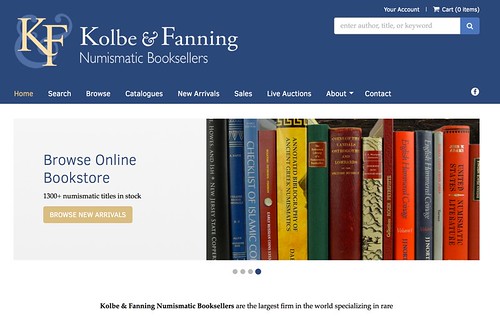
To visit the updated web site, see:
www.numislit.com
NEW BOOK: BENJAMIN FRANKLIN IN TERRA COTTA
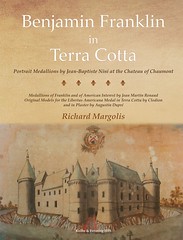 Kolbe & Fanning Numismatic Booksellers are proud to announce the publication of a new landmark
work by Richard Margolis: Benjamin Franklin in Terra Cotta. Portrait Medallions by Jean-Baptiste Nini at the Chateau of
Chaumont.
Kolbe & Fanning Numismatic Booksellers are proud to announce the publication of a new landmark
work by Richard Margolis: Benjamin Franklin in Terra Cotta. Portrait Medallions by Jean-Baptiste Nini at the Chateau of
Chaumont.
Decades in the making, this long-awaited work is finally available. Deemed “brilliant” by John W. Adams, the book has been very favorably received by experts in the field.
“ “Benjamin Franklin in Terra Cotta“ ... is an incredibly thorough piece of scholarship, including a detailed catalogue of all of
the known varieties of these generally 4 inch to 7 inch diameter plaques that are often collected alongside early American medals ...
Benjamin Franklin in Terra Cotta fills an important void in the numismatic literature surrounding Nini’s Franklin plaques and related
items.”
— John Sallay, President, Medal Collectors of America
“There is much to commend in this book by Richard Margolis, focusing on Nini’s 1777-1779 terra cotta portraits of Benjamin Franklin and
the moulds used to create them. The result of over forty years of painstaking research by the author, the volume is essentially a catalogue
raisonné of the artist’s most popular series of bas-relief portraits. The author states in his foreword that ‘some nuggets of relevant
information may have eluded’ him, but there can’t be many!”
— Anne Bentley, Curator of Art, Massachusetts Historical Society
“Benjamin Franklin in Terra Cotta advances the iconographic scholarship on the portrait medallions and moulds created by
Jean-Baptiste Nini, Jean Martin Renaud, and Claude Michel (Clodion). Scholars, art historians, curators and collectors will greatly benefit
by acquiring Mr. Margolis’s thorough and amply illustrated volume. Kudos to Kolbe & Fanning for producing a beautifully printed reference
work that Franklin would certainly have found useful.”
— Roy E. Goodman, Emeritus Curator of Printed Materials, The American Philosophical Society Library & Past President, The Friends of
Benjamin Franklin
Far surpassing a mere listing of varieties, Margolis’s text extensively discusses the ways in which originals can be distinguished from aftercasts and educates the reader regarding the artistic, technical and iconographic context within which these pieces were created. Extensive footnotes provide the reader with avenues to further information without clogging the primary text with minutiae. Intended to be useful to both the novice as well as the expert, the author is careful to show his thought processes, making explicit his methodology and citing his sources throughout. The handsome, large-format volume is finely illustrated throughout in full color and features a signature-sewn binding in high-quality cloth and an enticing pictorial dust jacket.
BENJAMIN FRANKLIN IN TERRA COTTA. PORTRAIT MEDALLIONS BY JEAN-BAPTISTE NINI AT THE CHATEAU OF CHAUMONT.
Margolis, Richard
Gahanna: Kolbe & Fanning, 2015. Folio (13 by 10 inches), original terra cotta cloth; gilt; jacket. 232 pages; illustrated in color. New. Item #3473
Price: $195.00
For more information, or to order, see:
BENJAMIN FRANKLIN IN TERRA COTTA. PORTRAIT MEDALLIONS BY JEAN-BAPTISTE NINI AT THE CHATEAU OF CHAUMONT.
(www.numislit.com/pages/books/3473/richard-margolis/benjamin-franklin-in-terra-cotta-portrait-medallions-by-jean-baptiste-nini-at-the-chateau-of)
To read the earlier E-Sylum article, see:
NEW BOOK: BENJAMIN FRANKLIN IN TERRA COTTA
(www.coinbooks.org/esylum_v18n10a03.html)

NEW BOOK: 2016 OFFICIAL BLUE BOOK
 Whitman Publishing Expands 73rd-Edition OFFICIAL BLUE BOOK™ With New Illustrated Coin-Grading Guide
and More
Whitman Publishing Expands 73rd-Edition OFFICIAL BLUE BOOK™ With New Illustrated Coin-Grading Guide
and More
The newest edition of the Handbook of United States Coins debuts on May 6, 2015. Known to collectors as the Blue Book, it is the best-selling annual guide to wholesale prices paid by U.S. coin dealers. The 73rd edition, with a 2016 cover date, has been fully updated and expanded by 16 pages. It can be ordered online (including at Whitman.com) in two formats—hardcover at $12.95 and softcover at $9.95—and is also available from booksellers and hobby shops nationwide. Members of the American Numismatic Association can borrow the book without charge from the Dwight N. Manley Numismatic Library.
The Blue Book was introduced in 1942 as a resource for coin collectors to learn how much dealers were paying, on average, for U.S. coins. Whitman Publishing’s R.S. Yeoman, who was in charge of promoting the company’s line of coin boards and folders in the 1930s, realized that coin collectors needed other resources and supplies for their hobby, and he began compiling mintage data and market values. This coin-by-coin, grade-by-grade research grew into the Blue Book. It has been published every year since 1942 (except for 1944 and 1950), with millions of copies purchased by collectors and dealers.
The Blue Book features more than 25,000 wholesale valuations in up to nine grades per coin type. It covers U.S. coins from copper half cents through gold double eagles, plus commemoratives; Proof and Mint sets; silver, gold, and platinum bullion coins; private and territorial gold pieces; private tokens; and 1903–1945 Philippine coins struck under U.S. sovereignty.
The 73rd-edition Blue Book has 288 pages—16 pages more than the 72nd edition. The “Silver and Related Dollars,” “Commemoratives,” and “Bullion” sections have all been expanded. In addition, the 73rd edition includes three new appendices. The first is an illustrated essay on how to sell tokens and medals, including merchant tokens, Hard Times tokens, Civil War tokens, souvenir medals, political and presidential exonumia, Franklin Mint medals, transportation tokens, and others. The second new appendix is a report of the top 25 U.S. coin prices realized at auction, ranging from $1,840,000 for an 1873-CC dime to more than $10 million for a 1794 silver dollar. The third new appendix is an eight-page feature on “Grading Coins and How Grade Affects Value,” a photo-illustrated guide with enlarged grade-by-grade images for Wheat cents, Buffalo nickels, Mercury dimes, Standing Liberty quarters, Liberty Walking half dollars, and Morgan dollars. This section is designed to educate new coin collectors, as well as non-collectors who have inherited or otherwise acquired old coins.
“We’ve heard from many coin dealers who wanted a feature like this,” said Whitman publisher Dennis Tucker. “Non-collectors who call coin shops often have no knowledge of grading, and they typically overestimate the condition of their coins. Grading is challenging to explain over the phone. The new Blue Book guides the reader visually, with compare-and-contrast photos of Good, Very Fine, and Mint State examples for six of the most commonly seen old coins.”
In addition to these new features, the 73rd-edition Blue Book now includes a helpful glossary of coin-collecting jargon, and a bibliography of books recommended for further hobby education.
The cover of the softbound 73rd edition shows three beautiful and historic American coins: a 1900 Barber half dollar, an 1836 Gobrecht silver dollar, and a 1993 Thomas Jefferson commemorative silver dollar.
“Before the Blue Book, collectors and dealers had no single, neutral source of detailed information and wholesale (buying) prices for every U.S. coin series,” said Q. David Bowers, past president of the American Numismatic Association and author of the Expert’s Guide to Collecting and Investing in Rare Coins. “If you own coins and you wonder ‘How much are they worth?’ you need a copy of the Blue Book.”
Handbook of United States Coins, 73rd edition
288 pages
By R.S. Yeoman; edited by Kenneth Bressett
$12.95 hardcover (ISBN 0794843115)
$9.95 softcover (ISBN 0794843123)
For more information, or to order, see:
2016
Handbook of United States Coins, 73rd Edition, Blue Book (Hardcover)
(/www.whitman.com/store/Inventory/Detail/2016-Handbook-of-United-States-Coins-73rd-Edition-Blue-Book-Hardcover+0794843115)
2016
Handbook of United States Coins, 73rd Edition, Blue Book (Softcover)
(www.whitman.com/store/Inventory/Detail/2016-Handbook-of-United-States-Coins-73rd-Edition-Blue-Book-Softcover+0794843123)
NEW BOOK: FROM BACTRIA TO TAPROBANE
Authors (s): Osmund Bopearachchi (Author)
Format: Hardcover
ISBN-13: 9789350980682
Pages: xxvi+1167p., Colour; B/W Plate; Figures
Pub. date: 30.04.2015, 1st. ed.
Publisher: Manohar Publishers & Distributors
Language (s): English
Bagchee ID: BB93420
List price: US $ 295,00
Bagchee price: US $ 265,50
Member price: US $ 238,95
Overview for From Bactria to Taprobane: Selected Works of Osmund Bopearachchi (In 2 Volumes)
Contents: Vol I: Central Asian and Indian Numismatics: Preface. 1. Pre-Bactrian Numismatics 2. Bactrian and Indo-Greek Numismatics. 3. Indo-Scythian, Indo-Parthian and Kushan Numismatics. 4. Cultural Heritage of Afghanistan. Index.
The first volume comprises Osmund Bopearachchi’s most important articles on the numismatics of Central Asia and India, particularly of pre-Bactrian, Graeco-Bactrian, Indo-Greek, Indo-Parthian and Kushan Coins. There are 36 articles on numismatics and 3 on the destruction of Afghanistan’s cultural heritage during the period of Civil War.
It is well known that from the time of Theodore Bayer, the reconstruction of the history of Greek settlers of Alexander the Great in Bactria and India and their nomadic successors, Scythians, Parthians and Kushans, has depended mainly on coins. It is only in the light of these coins that the rare ancient texts and the limited archaeological evidence can be used for writing their history.
Since the publication of Bopearachchi’s first book, Monnaies Greco-bactriennes et indo-grecques, Catalogue raisonne (1991), nearly half a million coins have surfaced in Afghanistan and Pakistan as a result of accidental finds and illegal excavations. His research is mainly based on these new discoveries. Through his work he has brought to light new kings, coin types, monograms, overstrikes and coin hoards.
Bopearachchi has also shown that the history of Greeks and their successors in Central Asia and India can no longer be written based solely on numismatics. He has taken into consideration other forms of human activities such as architecture, sculpture, epigraphy, ceramics and artefacts and shows it amply in his writings based on his own investigations and the contributions of eminent archaeologists, historians, numismatists, epigraphists and art historians of Central Asia and India.
Vol II: Art History and Maritime Trade: Preface. 1. Central Asian and Indian art. 2. South Indian and Sri Lankan art. 3. Maritime trade in the Indian Ocean. Index.
The second volume of Osmund Bopearachchi has articles and monographs on Central Asian and Indian art, South Indian and Sri Lankan art and finally maritime trade in the Indian Ocean. While documenting thousands of coins in the Pakistani markets from 1992 onwards. Bopearachchi realized that one has to go beyond the traditional approach of simply cataloguing coins, and as a result he has made an attempt to link numismatics with sculptural and pictorial iconography.
His studies on Utpalavarna, the courtesan who later became a bhiksuni (Buddhist nun) and on the earliest iconography of Hindu gods like Siva, Brahma, Visnu and Varaha have revolutionised our knowledge of these domains.
His writings giving the result of the archaeological excavations and explorations carried out by the department of archaeology and the French Archaeological Mission in Sri Lanka along the estuaries and rivers provide substantial evidence to indicate that in ancient times large ships could cast anchor in the sea close to river mouths and commodities were taken to inland markets using the rivers and waterways.
His work also shows how the movements caused by these human activities have amalgamated local traditions with foreign identities and created new forms of art and belief. His research on sculptures imported to the island from Amaravati-Nagarjunakonda deals with the inspiration of these schools of art over the early forms of Buddhist sculpture in Sri Lanka. The different architectural aspects of the royal palace complex of Sigiriya, build by King Kassapa (477-95 CE) clearly demonstrate that various external ideas and concepts were used to convert this huge lofty rock into a more elaborate harmonious whole, in another words a paradise or an Alakmanda.
For more information, or to order, see:
From Bactria to
Taprobane: Selected Works of Osmund Bopearachchi (In 2 Volumes)
(www.bagchee.com/books/BB93420/from-bactria-to-taprobane-selected-works-of-osmund-bopearachchi-in-2-volumes)
NEW BOOKS IN THE MONETA SERIES: #185-187
Latest MONETA publications (April 2015)
Documents and Studies on 19th c. Monetary History, England, Republications of Royal Commission appointed to Inquire into the Recent Changes in the Relative Values of the Precious Metals
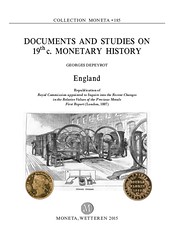 M
185, First Report (London, 1887), G. Depeyrot, ed., Collection Moneta, 185, Wetteren, 2015, X + 324 + 9* p. ISBN
978-94-91384-53-0
M
185, First Report (London, 1887), G. Depeyrot, ed., Collection Moneta, 185, Wetteren, 2015, X + 324 + 9* p. ISBN
978-94-91384-53-0
For more information, or to order, see:
www.moneta.be/volumes/moneta_185.htm
M 186, Second Report (London, 1888), G. Depeyrot, ed., Collection Moneta, 186, Wetteren, 2015, X + 284 + 9* p. ISBN 978-94-91384-54-7
For more information, or to order, see:
www.moneta.be/volumes/moneta_186.htm
M 187, Final Report (London, 1888), Appendix to Final Report (London, 1888), G. Depeyrot, ed., Collection Moneta, 187, Wetteren, 2015, VIII + 172 + 266 + 15* p. ISBN 978-94-91384-55-4
For more information, or to order, see:
www.moneta.be/volumes/moneta_187.htm
BOOK REVIEW: IN HONOR AND MEMORY
Howard Daniel writes:
Here is a review of a book I recently received from the authors. It is a fantastic book and is related to numismatics by identifying the installations and facilities that issued military tokens during the Vietnam War in Vietnam, Laos, Cambodia, Thailand, Okinawa and Guam. The numismatists who collect these tokens will be blown away with this book.
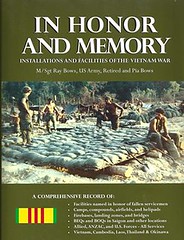 In Honor and Memory, Installations and Facilities of the Vietnam War, by Ray & Pia Bows, Bows and Company, New Smyrna Beach,
Florida, ISBN 978-0929973-07-4, LOC 2014-940883, 1st edition, 2014, 772 pages.
In Honor and Memory, Installations and Facilities of the Vietnam War, by Ray & Pia Bows, Bows and Company, New Smyrna Beach,
Florida, ISBN 978-0929973-07-4, LOC 2014-940883, 1st edition, 2014, 772 pages.
The book begins with over 600 pages identifying all of the U.S. and Allied military installations, facilities and monuments in Vietnam. Most of them were named after the heroes of the war, but there are also those named after historical organizations, places and other people. I found the names of several men I had forgotten and did not know installations and facilities had been named for them. I also found some places I had visited that I had not remembered their names.
The next section has Maps and there are a large number of them. The maps pinpointing all of the installation and facility locations are worth their weight in gold. Many of them described in other books were never identified to their exact location. The third section describes the installations and facilities in Cambodia, Laos, Thailand, Okinawa and Guam. Many readers may be surprised at the number of them that are related to the Vietnam War.
The fourth section is a Cross Reference that makes a researcher’s job incredibly easy with many, many cross references. Then there is also a very large Index at the back of the book. If you cannot find what you are looking for in the Cross Reference and the Index, you did not carefully read them. I knew the authors did a lot of research but the Bibliography blew me away. It is HUGE! There are many references in it that I need to buy or borrow for research into my Southeast Asian numismatic field.
For those who collect the military tokens related to the installations and facilities, the background information will greatly increase their knowledge about them. It might also help those with unidentified tokens to resolve their identification. If a reader can identify a token because of this book, please contact the authors. For those who collect other tokens, they might consider writing a similar reference for their specialty.
The book can be ordered from www.BowsMilitaryBooks.com or www.in-honor-and-memory.com. If you contact the authors, you might be allowed a "Daniel" discount for it.
BOOK REVIEW: VICTORIA’S CROSS
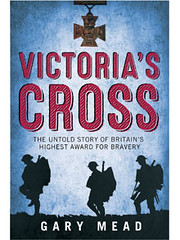 Victoria’s Cross: the Untold Story of Britain’s Highest Award for Bravery by Gary Mead 352pp, Atlantic, Telegraph offer price: £20
(RRP £25, ebook £15.19). Call 0844 871 1515 or see books.telegraph.co.uk
Victoria’s Cross: the Untold Story of Britain’s Highest Award for Bravery by Gary Mead 352pp, Atlantic, Telegraph offer price: £20
(RRP £25, ebook £15.19). Call 0844 871 1515 or see books.telegraph.co.uk
This book is not simply another collection of heroic VC stories. It is, rather, a critique of the criteria by which the medal is awarded, and its conclusions about the arbitrary nature of many VC awards are quite disturbing.
The VC began life in 1856 during the Crimean War because of a widespread feeling that deeds of incredible courage, such as the Charge of the Light Brigade, were insufficiently recognised. Like many good Victorian ideas, the medal’s name was thought up by the queen’s clever German husband, Prince Albert, who viewed it as a way of polishing the monarchy’s prestige.
Mead makes much of the random nature of the award, and the absence of any women VC winners, although there is nothing in the rules that precludes women from winning it. He cites some women who were actively involved in combat who he feels ought to have won the medal, but were denied for reasons of old-fashioned sexist chauvinism.
But Mead does not set out to devalue the VC by questioning its criteria. His hope is that the number of hoops VC winners have to jump through before grasping the legendary award – which often means that their medals are posthumous – should be knocked down, making the lustre of the little cross inscribed simply “For Valour” shine more brightly than ever.
To read the complete article, see:
Victoria’s Cross: the Untold Story of Britain’s Highest Award for Bravery by Gary Mead, review: 'disturbing conclusions'
(www.telegraph.co.uk/culture/books/bookreviews/11573322/Victorias-Cross-the-Untold-Story-of-Britains-Highest-Award-for-Bravery-by-Gary-Mead.html)
THE BOOK BAZARRE
MORE ON OVERSTRUCK JENNY LIND MEDALS
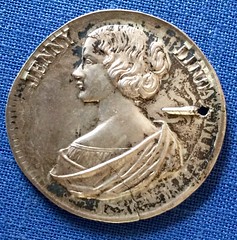
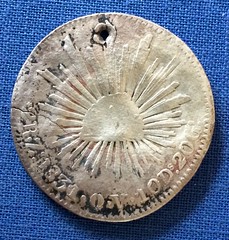
Last week Ralf Böpple asked about his recent eBay find:
... an 1831 Mexican two bits overstruck with the bust of Jenny Lind. I could not find much on Jenny Lind medals, and as far as I remember leafing through the ANS Numismatic Notes publication on her medals a good while back, it's not in there. Is this a newer creation, or is this actually contemporary to the 1850 tour of the U.S. of the "Swedish Nightingale"?
Alan V. Weinberg writes:
This circa 1960's restrike from original obverse dies is fairly common and comes overstruck on silver dollars and other various coins, including a Swedish 2 skilling currently on eBay.
A reader writes:
I am aware of 4 or 5 such overstruck coins sold on eBay by a token dealer out of Henderson NC. I bought one recently and inquired of the seller when the die was made and the coins overstruck. The reply was that the die was made in the 1880s and the coins overstruck sometime in the 20th century, dealer did not know when. The dealer said I knew as much as they knew. I would be interested in knowing when they first came on the market.
Rich Hartzog writes:
Some years ago I was President of the Chicago Coin Club, and I collected CCC medals. Two off-shoots of the CCC were the Chicago Numismatic Roundtable and the Chicago Numismatic Society. The CNR was active in the 1940's, with C. Sam Carlson (ANA 4162 in 1932, died 1978) a driving force.
Carlson's specialty was Swedish coinage. He had a particular love for Jenny Lind, and under the auspices of the CNR had issued (probably by J Henri Ripstra, ANA LM 29, Numismatic Hall of Fame, died 1961) a large number of medals overstruck on various coins. This "stock" die of Lind comes struck on a wide variety of coins, generally in very small mintages for each undertype. Overall his output was large.
I have a fair collection of these, perhaps several dozen different. Carlson and the CNR also issued imitation Swedish Plate Money, with corners struck with a "CNR" die, in very small quantities. I have two different.
Jonathan Brecher writes:
There was a big group of those Jenny Lind medals in the July 10-11, 1998 Presidential Coin and Antiques auction - Lot 705.
A BIZARRE GROUP OF 36 JENNY LIND TOKENS STRUCK OVER VARIOUS COINS, TOKENS & ODDMENTS, ND. A 30.8mm obverse die featuring a draped bust left of Jenny Lind to the left, her name to either side has been used to overstrike a weird assortment of coins, tokens and miscellaneous planchets. The die is unsigned, but our consignor ascribes the work to Trygve Rovelstad, the Chicago artist best known for his Elgin commemorative half dollar. Some of the overstrikes are done with a perfect die while others were executed after the die had received a long cancellation gouge in the right field. This collection is from the estate of Ragnar Cederland, a member of the Chicago Coin Club and an avid collector of Jenny Lind tokens and medals. They were probably made to his order.
Ralf Böpple adds:
This perfectly explains all the questions I had in connection with this medalet. I had already suspected a numismatist's work behind it but had no idea that - and if so, how - Jenny Lind would still inspire the striking of her portrait so many decades after her tour (although I imagined 1950/1951, the centenary, to be its most likely raison d'être).
It's great to be able to put a story behind this item.
To read the recent eBay lot description (from Henderson, NC), see:
OVERSTRUCK JENNY LIND MEDAL. Struck on a Swedish 2 skilling.
To read the earlier E-Sylum article, see:
QUERY: JENNY LIND MEDAL OVERSTRUCK ON MEXICAN 2R
(www.coinbooks.org/esylum_v18n17a28.html)
NOTES FROM E-SYLUM READERS: MAY 3, 2015
U.S. Mint Screw and Hydraulic Presses
John Dannreuther writes:
A small correction to the discussion about the 1895 Morgan dollars in last week's E-Sylum: The Mint did use the old large screw press (called the medal press or sometimes, the dollar press) to strike Proof coins through 1893. Starting in 1894, all Proof coins were struck on hydraulic presses, although they were produced in the medal room.
Jeff Starck of Coin World adds:
Roger Burdette’s article about 1895 Morgan $1s appeared in the September 2006 issue of Coin Values.
To read the earlier E-Sylum article, see:
MORE ON THE SILVER DOLLARS OF 1895
(www.coinbooks.org/esylum_v18n17a20.html)
Another Coin Card Postcard Album
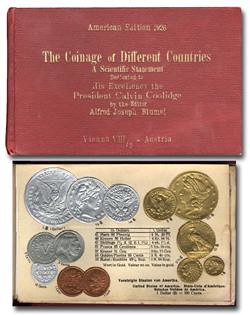 Regarding coin card postcard albums, John and Nancy Wilson write:
Regarding coin card postcard albums, John and Nancy Wilson write:
For information and keeping an accurate census, Arlie Slabaugh presented us with his copy of the "American Edition 1126, The Coinage of Different Countries", the President Coolidge copy from the Editor A. J. Blumel and at bottom Vienna - Austria. It is a very nice copy with very little foxing. Inside the back cover it has a stamp "Foreign Department - The Citizens National Bank of Los Angeles." It has a maroon cover like the one pictured in your story.
To read the earlier E-Sylum article, see:
COIN CARD POSTCARD ALBUM CENSUS (www.coinbooks.org/esylum_v17n02a29.html)
Bill Eckberg's 1794 Cent Cake
Happy Birthday to Bill Eckberg, who celebrated the day at the Early American Coppers convention in Dallas this weekend. His fellow copper
collectors surprised him with a cake decorated with the world's sweetest 1794 cent. Neat!

THE MONTROVILLE WILSON DICKESON ARCHIVE
Regarding the Montroville Dickeson photo discussed in recent issues, Joel Orosz writes:
I've always wondered who owned the original of the photo of which I own a copy--now I know!
My authority for stating that Bob Wester found the original of this photo comes from the lot 208 description in the Money Tree's Mail Bid Sale 24, Part 1, November 18, 1995. I bought the copy from that sale. I attach a scan of the description for reference.
It seems as if the more we examine this photo, the more confused matters become.
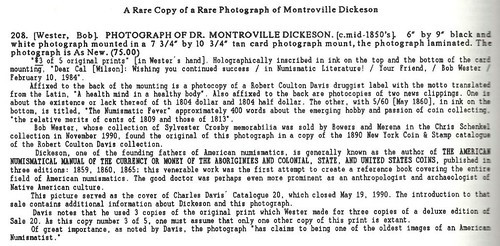
David Sundman writes:
Some of our readers may have discovered the Montroville Wilson Dickeson collection of archival material held at the University of Pennsylvania. While the collection appears to be entirely non-numismatic, it might be worth a look by someone researching Dr. Montroville Wilson Dickeson’s life.
 The Montroville Wilson Dickeson Collection is a record of his expedition to the Mississippi and Ohio Valleys to investigate the origins
and archaeology of the North American mound builders. Dickeson traveled the region from 1837 to 1844 pioneering in the use of trenches
and cross-sections to excavate the sites. The collection consists of two catalogues of artifacts, one with journal entries, hand-drawn
maps and plans, cross-section drawings, artifact drawings, and Dickeson's renderings that were used later in the creation of The
Mississippi Panorama by John J. Egan.
The Montroville Wilson Dickeson Collection is a record of his expedition to the Mississippi and Ohio Valleys to investigate the origins
and archaeology of the North American mound builders. Dickeson traveled the region from 1837 to 1844 pioneering in the use of trenches
and cross-sections to excavate the sites. The collection consists of two catalogues of artifacts, one with journal entries, hand-drawn
maps and plans, cross-section drawings, artifact drawings, and Dickeson's renderings that were used later in the creation of The
Mississippi Panorama by John J. Egan.
Additional materials include photographs of sections of the panorama and of the artifacts displayed at The Centennial Exhibition, exhibition panels, and an advertising broadside for the Missisippi Panorama and Dickeson lectures. A group of doodles and some written data, including original labels, round out the collection. Materials which arrived with the collection but are not a part of it are plates from Dickeson's Numismatic Manual, plates from the Crania britannica, and a copy of C.S.Rafinesque's Lists of Mounds in North America which reflect some of Dickeson's other interests and publications.
The collection does include at least some numismatic material:
Five copies of the advertising broadside for the Panorama "Monumental Grandeur of the Mississippi Valley" with "Scientific lectures on American Aerchiology" are placed in a folder in the map case. Other oversized plates taken from the Crania britannica and Dickeson's The American Numismatic Manual are with the oversize materials.
To access the Dickeson archive finding aid, see:
Montroville Wilson Dickeson collection
(http://hdl.library.upenn.edu/1017/d/ead/upenn_museum_PUMu1080)
To read the earlier E-Sylum article, see:
THE ORIGINAL MONTROVILLE DICKESON PHOTO
(www.coinbooks.org/esylum_v18n17a23.html)
THE BOOK BAZARRE
ON THE RARITY OF THE 1874 TREATY MEDALS
As soon as I read the segment on the "unique" 1874 Canadian Indian Peace medal that Jeff Hoare auctions sold for $40,000 last year and is being exhibited currently by the buyer as "unique", I went to my May 2007 Stack's John J. Ford sale catalogue part XVIII, an auction which I attended. I had known this medal attribution was grossly inaccurate.
Ford 2007 sale Lot 19 is a superb Proof silver 1873 Treaty Three medal w/suspension at $5500 hammer, lot 20 an Ex Fine silver 1874 Treaty Four medal with suspension at $6,000 hammer , lots 21 -22 two silver 1875 Treaty Five medals with suspension choice Proof and Abt Unc at $6000 and $3000 hammer, lot 23 a choice Proof 1876 Treaty Six silver medal with suspension at $6000 hammer, lots 24-25 two silver Proof and Abt Unc Treaty Seven with suspension medals at $6500 and $8500 hammer and then finally lots 26 thru 28 a series of three silver Proof silver Undated and unnumbered 187...medals with suspension at $2200,$ 2200 and $1600 hammer. These followed by a series of six bronzed copper Canadian Victoria IPM's of the same design and size as the silvers, three dated 1874.
Note: all of the above silvers and bronzes are the exact same design obverse and reverse except for the final digit 3 to 7 stamped in the date.
So the silver $40K 1874 Hoare medal is not even close to being unique and the increase in price from 2007 $5500 -$6K price range to the 2014 $40K level is astonishing. Indeed, in general the Ford Indian Peace Medal prices realized (both sales 2006 & 2007) were a high point in the market.
To read the earlier E-Sylum article, see:
1874 TREATY 4 MEDAL ON DISPLAY (www.coinbooks.org/esylum_v18n17a26.html)
EXHIBIT: WE ARE ONE
Anne Bentley of the Massachusetts Historical Society writes:
Readers who visit Boston this summer will have the chance to view the gold Comitia Washington Before Boston medal on display at the Boston Public Library in an exhibition titled We Are One.
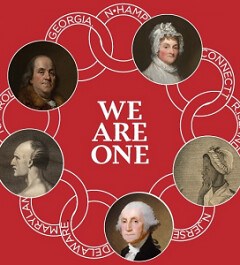 We Are One: Mapping America’s Road from Revolution to Independence
We Are One: Mapping America’s Road from Revolution to Independence
May 2 through November 29 2015 – Boston
2016 - Colonial Williamsburg
2017 - New-York Historical Society
Opening May 2, 2015, the Norman B. Leventhal Map Center will present an exhibition that commemorates the 250th anniversary of Britain’s 1765 Stamp Act. This pivotal moment sparked American opposition to Britain’s restrictive colonial policies, particularly taxation without representation, which was established to help pay for troops stationed in the colonies during the French and Indian War (1756-1763). Protestors in Boston hung one of the tax collectors in effigy on an elm tree near the Boston Common. The tree became known as the Liberty Tree, and the loose organization of protestors were known as the Sons of Liberty. This early opposition throughout the colonies to British imperial control set the stage for growing opposition to British rule during the next ten years, resulting in the American Revolutionary War.
We Are One maps the American road to independence. It explores the tumultuous events that led thirteen colonies to join to forge a new nation. The exhibition takes its title from Benjamin Franklin’s early design for a note of American currency containing the phrase “We Are One.” This presaged the “E Pluribus Unum” found on the seal of the United States, adopted in 1782, and on all U.S. coins.
Using geographic and cartographic perspectives, the exhibition traces the American story from the strife of the French and Indian War to the creation of a new national government and the founding of Washington, D.C. as its home. Exhibited maps and graphics show America’s early status as a British possession: thirteen colonies in a larger trans-Atlantic empire. During and after the French and Indian War, protection of those thirteen colonies exhausted Britain economically and politically, and led Parliament to pass unpopular taxes and restrictions on her American colonial subjects. The Stamp Act, the Tea Act, and limits on colonial trade and industry incited protests and riots in Boston, as contemporaneous portrayals in the exhibition show.
When tensions between Britain and her American colonies erupted into war, British cartographers and other witnesses depicted military campaigns, battles, and their settings. These maps, drawings, and military artifacts now bring the long, bloody struggle for independence to life.
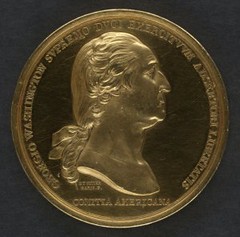
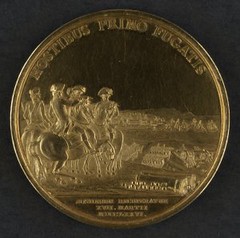
In 1776 Congress voted to honor George Washington with a gold medal for ending the siege of Boston and forcing the British troops to evacuate. They commissioned a French engraver to create the medal, which was minted in 1789. On the hundredth anniversary of the evacuation, Bostonians purchased it from Washington’s heirs and donated it to the Boston Public Library. The medal features a profile of Washington on one side and a group of officers watching the British troops leave the city on the other. The profile portrait alludes to ancient Roman and Greek coins, artifacts of societies that influenced the new American government.
To read the complete article, see:
We Are One 54
(www.bpl.org/exhibitions/current-exhibitions/we-are-one/view-the-exhibition-3/we-are-one-54/)
For more information, see:
http://maps.bpl.org/weareone
http://maps.bpl.org/content/upcoming-exhibitions
AUTHORS SEEK ASSISTANCE FOR 1792 BOOK
CALL FOR ASSISTANCE ON 1792: BIRTH OF A NATION’S COINAGE
 Len Augsburger, Joel Orosz, and Pete Smith are nearing completion of the manuscript for their new book, 1792: Birth of a Nation’s
Coinage, to be published by Heritage Auctions. This will comprise the first book-length study of the U.S. Mint’s coinage of 1792:
silver center cent; fusible alloy cent; Birch cent; half disme; disme; and the undenominated eagle-on-globe pieces. The full story of these
great rarities will never be reconstructed, but our study will reveal many previously-unknown facts, and settle a few controversies that
have circulated for decades.
Len Augsburger, Joel Orosz, and Pete Smith are nearing completion of the manuscript for their new book, 1792: Birth of a Nation’s
Coinage, to be published by Heritage Auctions. This will comprise the first book-length study of the U.S. Mint’s coinage of 1792:
silver center cent; fusible alloy cent; Birch cent; half disme; disme; and the undenominated eagle-on-globe pieces. The full story of these
great rarities will never be reconstructed, but our study will reveal many previously-unknown facts, and settle a few controversies that
have circulated for decades.
The book’s first appendix consists of an exhaustive census, with pedigrees where known, and photographs when available, of all of these first attempts to create a coinage for the United States. This census will provide an invaluable tool for catalogers and collectors alike, tracing the ownership of these coins, in some cases, back to the great collectors and dealers of the 19th century, including names such as Mickley, Garrett, Parmelee, Woodward, and Cogan.
Our census has documented a solid majority of the surviving coins of 1792, but we haven’t found them all. If you own any of the coins listed above, and have not discussed them with us, we ask you to step forward and place your name into the census (if you choose, we will include pertinent facts about your coin, but keep your identity absolutely confidential). If you do not own any such coins, but know of someone who does, we would be grateful for a referral.
Our goal is to publish the most complete possible census and pedigree as the standard record of the coinage of 1792, and of the collectors/curators who have preserved these national treasures for our delight and edification. We would be very grateful to receive any information about ownership of the coinage of 1792. Please contact Pete Smith at petesmith1793@gmail.com
Thanks very much!

DAVID LANGE'S LINCOLN CENT TOKENS
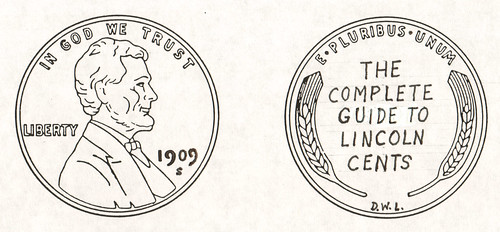
The illustrations of Ken Potter's GOOD FOR tokens reminded me of my own experience in commissioning tokens from the Gallery Mint to commemorate publication of my book The Complete Guide to Lincoln Cents in 1996. I may have submitted something about this to The E-Sylum previously, but I took out these tokens to study recently, and I can provide a little more information than before.
For my first two books in the Complete Guide series I had ordered wooden nickels to give out to anyone I encountered in the hobby, but the cent book was a much grander project, and I wanted to provide a little more substantial souvenir. I had gotten to know engraver Ron Landis from our times together at the ANA Summer Seminars, so I asked him to prepare token dies based on the sketch I supplied him. I used the grading illustration from an early edition of the ANA's grading guide and simply modified it as needed.
Ron worked fairly quickly and sent me three tokens as samples of his dies. These were struck over a circulated Memorial Cent of unreadable date (#1), an uncirculated 1980 Memorial Cent (#2) and a brass planchet of his own making (#3). The work was very crude, just like my sketch, and I've always wondered whether he did this intentionally as a literal interpretation of my scribbles.
I expressed to him my disappointment that the samples looked nothing like real cents, and I sent him a genuine coin from which to make transfer dies as a model for his revised token dies. The result was a fairly convincing imitation of a 1909-S V.D.B. cent into which he punched the word COPY on both sides. Ron coined this one in medal rotation to further distinguish it from an actual coin. I immediately said that he was on the right track, and I gave him the thumbs up to proceed with the modified reverse die having my inscriptions.



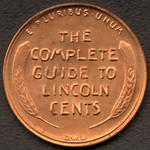

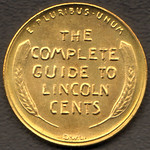
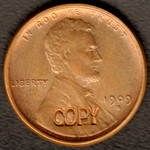

This last step was never performed. Ron and I had shared the four sample pieces with fellow instructors and others at the 1996 ANA Summer Seminar. A few days later I learned from Ron that some busybody within the ANA informed him that he was counterfeiting and that the ANA would not allow that. It didn't make any difference that the tokens as actually struck would have customized reverse legends that couldn't possibly lead to their being sold as genuine coins. Ron got spooked and backed away from the whole project, letting me keep the samples without charge as a consolation. I gave up on commemorating my book in any way, so there were no wooden nickels this time!
To read the earlier E-Sylum article, see:
KEN POTTER'S MICHIGAN GOOD FOR TOKENS
(www.coinbooks.org/esylum_v18n17a38.html)
GEORGE CUHAJ PERSONAL MEDAL

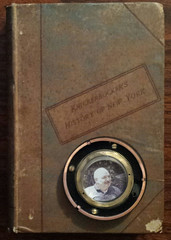
My sculptor/artist friend, James MaloneBeach of Mt. Pleasant, Mich. is making a series of personal tribute medals for friends of his. This is what he did for me, using my New York History knowledge base.
A copy of Washington Irving's Knickerbockers History of New York, with a cut-out thru the cover, and on the flyleaf is pasted a portrait of James Fenimore Cooper. The insert is a photo of me, set into an exquisite handcrafted copper and brass frame. The reverse of the medal has Cuhaj bio text from my Wikipedia page acid etched into it.
1859 SAGE NUMISMATIC BOOKS RAFFLE TOKEN
November 1859 A. B. Sage Numismatic Books Raffle Token
This token is currently listed on eBay #111660596273 The seller is JRH Specialty Services of NJ who acquired the token from Steve Tanenbaum

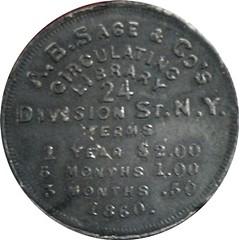
The seller says it is an unlisted variety of a G. H. Lovett token. He did not say how it differed from what is listed. Or give a size.
What I don't understand are the 'terms'? How did they work? Are they the cost of a library card?
In any case, a famous maker, a famous numismatic bookseller with the Tanenbaum imprimatur.
As an item of interest, how many numismatic books would Sage have owned in 1859?
I've always been fascinated by this token, but never acquired one for my collection. QUICK QUIZ: There were at least TWO raffles in the world of 19th century American numismatics. What are the others? -Editor
To read the complete eBay lot description, see:
1859 M-NY-765 Var A. B. Sage & Co. by G.H. Lovett SWM unlisted variety
(www.ebay.com/itm/111660596273)
THE BOOK BAZARRE
ANS MANTIS DATABASE HOSTS 100,000 COIN IMAGES
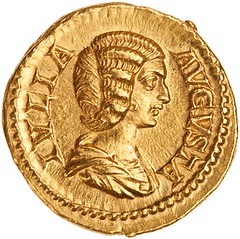 Continually adding to an already comprehensive database, the American Numismatic Society (ANS) is happy
to announce that the 100,000th image has been added to the MANTIS database. MANTIS (A Numismatic Technologies Integration Service) provides
information on nearly 700,000 records for objects in the ANS collection.
Continually adding to an already comprehensive database, the American Numismatic Society (ANS) is happy
to announce that the 100,000th image has been added to the MANTIS database. MANTIS (A Numismatic Technologies Integration Service) provides
information on nearly 700,000 records for objects in the ANS collection.
The 100,000th image displayed is an aureus, a gold Roman Imperial coin from AD 196–211, featuring Julia Domna’s portrait on the obverse and the goddess Cybele seated on a throne in a car drawn by four lions on the reverse.
Dr. Gilles Bransbourg, Adjunct Curator of Roman Coins at the ANS, commented on the selection, “the American Numismatic Society’s long-term commitment in the field of digitization towards the larger public is unique. Such an investment contributes to enhancing global knowledge, access, and understanding of ancient and modern numismatics alike. The addition of our 100,000th image is a momentous development in our goal to continually enhance and expand this extensive database of worldwide coinage.”
Bransbourg offered further comment on the significance of Julia Domna, a ruling empress and wife and mother to emperors. “This rare piece displays a spectacular, strong, and symbolic reverse, associating the empress with the goddess Cybele. Cybele was called Magna Mater, the Great Mother, and her cult derived from very ancient Asian beliefs that were incorporated into the Greco-Roman pantheon as Eastern traditions moved West. Julia Domna was herself born in Syria, and her husband Septimius in Africa, a tribute to Roman multiculturalism.”
The coin can be viewed on the ANS website at http://numismatics.org/collection/1955.191.22.
As a search and display tool, MANTIS allows users to search the ANS’s massive holdings for items of interest through a series of easy to use screens; it also allows users to perform statistical and geographical analyses of groups of numismatic items. A related project, Online Coins of the Roman Empire (OCRE), an online tool to help in the identification, cataloging, and research of the coinage of the Roman Empire, is a joint initiative between the ANS and the Institute for the Study of the Ancient World (ISAW) at New York University. It will ultimately record every published type of Roman Imperial Coinage. It is funded in part by a generous grant from the Division of Preservation and Access of the National Endowment for the Humanities, made as part of the Humanities Collections and Reference Resources program, which will provide for the full implementation of OCRE.
COUNTERFEIT CONTINENTAL CURRENCY BROADSIDE
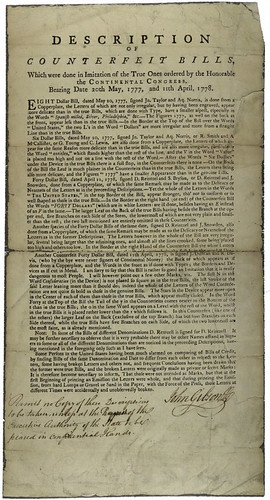 The Irish-American printer John Dunlap of Philadelphia produced this broadside in
1778/1779 at the direction of John Gibson, the auditor general for the Continental Congress. Dunlap’s most famous printing job was
undoubtedly the Declaration of Independence, the first copies of which are colloquially known today as ‘Dunlap broadsides,’ but he was also
the general printing contractor for the Continental Congress. This broadside is a single sheet measuring 8″ x 16″ and its
heading gives a fairly precise indication of its purpose:
The Irish-American printer John Dunlap of Philadelphia produced this broadside in
1778/1779 at the direction of John Gibson, the auditor general for the Continental Congress. Dunlap’s most famous printing job was
undoubtedly the Declaration of Independence, the first copies of which are colloquially known today as ‘Dunlap broadsides,’ but he was also
the general printing contractor for the Continental Congress. This broadside is a single sheet measuring 8″ x 16″ and its
heading gives a fairly precise indication of its purpose:
Which were done in Imitation of the True Ones ordered by the Honorable
the CONTINENTAL CONGRESS,
Bearing Date 20th May, 1777, and 11th April, 1778.
The $40 bill was the highest denomination of what are know as the Yorktown notes, since they were authorized by an April 11, 1778 resolution and printed in York, Pennsylvania, where the Continental Congress was temporarily residing. The broadside enumerates three separate fraudulent versions of the $40 note, and it might have been the most counterfeited of the era. The problem was so serious that large numbers of these Yorktown notes were simply destroyed, and this is what makes them the rarest and most expensive notes for collectors today. The fiasco only further depreciated the already shaky Continental Currency, which at this point was worth only between a quarter to a third of its nominal value, i.e. one dollar of silver was worth three or four dollars of paper money. By the end of the war, “not worth a continental” had entered the lexicon for something regarded as worthless.
The handwritten annotation at the bottom of the broadside reads: “Permit no copy of these descriptions to be taken unless at the request of the Executive Authority of the State to be placed in confidential hands.” It was also signed by the auditor general of the Continental Congress, John Gibson, for whom counterfeit bills were clearly a pressing issue, but it’s unclear how great of an aid this rather simple but detailed descriptive list was in combating the problem. Still it does offer a fascinating window into the financial schemes that the American colonists relied on to fund the war and the machinations that the British attempted to thwart them.
For British forces and their Loyalist allies, counterfeiting was also seen as a weapon of war, as this infamous advertisement published in a newspaper from British-occupied New York City makes clear.

The advertisement promised “exactly executed” counterfeit “Congress notes” to any person traveling into the colonies, observing that a large amount had already been circulated and that there was “no Risque in getting them off.” To be fair, there were a variety of opportunists on both sides who were successfully counterfeiting Continental Currency, but British efforts were certainly more organized and systemic.
To read the complete article, see:
COUNTERFEITING CONTINENTAL CURRENCY
(www.anspocketchange.org/counterfeiting-continental-currency/)
THE BOOK BAZARRE
1854 STONE & BALL COUNTERSTAMPED DIME
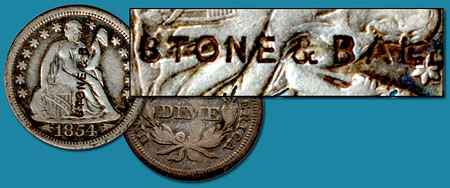
What would a hoard of exonumia such as mine be without some counterstamped coins? This installment we'll touch on one of my favorite collecting areas, counterstamped Liberty Seated dimes. I only collect them with full names, as they tell a better story than a coin with some randomly counterstamped numerals or letters ever could. I don't collect them with holes either.
The first counterstamped dime I ever bought, an 1854 Arrows variety, is marked STONE & BALL vertically across the obverse of the host coin. From what I've seen and learned, Seymour H. Stone and Calvin S. Ball sold jewelry and silverware and were also in the business of repairing clocks in Syracuse, New York circa 1853 to 1869. These prolific counterstampers put their mark – using three differing punch styles at various times – on numerous U.S. coin denominations as well as foreign pieces; the Brunk reference on counterstamped coins even notes a Stone & Ball impression on a Connecticut copper!
My little dime with the Stone & Ball counterstamp forms the nucleus of a collection that has been steadily growing in the past few years, and I'm having as much fun with it as I've had working on my date set of Liberty Seated dime love tokens without holes. It's a fun and rewarding challenge, and isn't that what coin collecting is all about?
To read the complete article, see:
“Stone & Ball – More Than a Rock and a Round Thing” (www.stacksbowers.com/NewsMedia/Blogs/TabId/780/ArtMID/
2678/ArticleID/65120/%E2%80%9CStone--Ball
-%E2%80%93-More-Than-a-Rock-and-a-Round-Thing%E2%80%9D.aspx)
STEVE ROACH OFFERS ANA MEMBERSHIP TO YNS
Growing our hobby starts at an individual level…and thank you
I’m often asked what it will take to get younger people involved in coin collecting.
For me, I followed a pretty normal path where my grandma gave me some old coins when I was 7. At 10 I started reading Coin World and a few years later I checked out a local coin club show. As I became absorbed in coins, it started to make more sense that it would become my career.
Throughout each step of my collecting journey, people were there to provide encouragement and guidance.
Simply put: it starts at the individual level.
Over the past six years at Coin World , I have had a chance to work with individuals who have made me sharper, wiser and have provided me an entirely new lens from which I can consider our hobby.
Crafting each weekly and monthly edition of Coin World is the work of a team and each staff member has put his or her heart in the stories that appear in our pages. The same can be said for those who work behind the scenes to help Coin World remain both readable and viable.
Knowing that Bill Gibbs will be leading the staff going forward in his new role as managing editor gave me the confidence I needed to move into a newly created editor-at-large role.
Since 1976, Bill has been a backbone of Coin World . He leads by example, always making sure that quality and accuracy define our stories. I’ll continue to work closely with the brand and with Bill so that Coin World — both in print and online — can continue to meet the needs of our hobby and our readers.
For me, stepping into an editor-at-large role made sense since the one thing I was missing at Coin World was actually physically working with coins. It’s one thing to share wonderful stories about the history of coins and our hobby, but as a collector at heart, there are few things that beat the experience of handling a coin.
My most meaningful moments in the hobby have come from introducing people to our hobby and helping people engage in it, and this new role will allow more of these interactions. When you see me at a coin show, make sure you say hi! I’m always excited to talk coins.
Which brings me back to the original question: What will it take to make young people interested in the hobby?
The American Numismatic Association has provided me with my foundation in numismatics, so why not spread the wealth?
If you’re a young numismatist (which means you’re under 18) or want to introduce a YN to the hobby, let me know! I’ll pay for a new one-year Gold ANA membership to the first 50 YNs who reach out to me by email at sroach@coinworld.com and let me know what they like about coin collecting.
I’ll end by saying thank you: to our staff, columnists, contributors and our many readers.
My personal journey in numismatics has been more than I could ever have imagined as a 10-year-old reading Coin World , and thankfully, it is far from over.

EMPEROR NORTON'S PROCLAMATION AND SEAL
... it was intriguing this week to stumble upon the following record, included in the Twenty-Fifth Annual Report of the Odd Fellows' Library Association of the City and County of San Francisco, for 1879-80. The President's, Librarian's and Finance Committee letters in the report all are dated 5 June 1880 — so, presumably, the report was published sometime that summer.
Emperor Norton had died just a few months earlier, in January 1880.
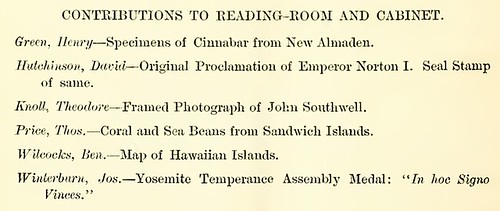
Notice the second listing, which indicates that an "Original Proclamation of Emperor Norton I," together with the "Seal Stamp of same," was contributed — donated — to the library of the Odd Fellows of San Francisco by a David Hutchinson.
Those who are up on the finer points of their Norton history will recall that Hutchinson and his wife, Eva, were the Emperor's landlord and landlady for the last ten of his 17 years at the Eureka Lodgings, on Commercial Street.
Was the document that David Hutchinson donated to the Odd Fellows' library in early 1880 Emperor Norton's final proclamation — written and sealed, but not yet delivered and published — something that would have offered a clue as to what the Emperor was thinking about on the last day of his life?
As to the artifacts themselves — the written proclamation and the seal stamp — those probably are lost to time and events.
The Odd Fellows Temple building (1884), which housed the library that received David Hutchinson's donation, was lost in the earthquake and fire of 1906. In his written response to my query about the Hutchinson items, Peter V. Sellars, an historian of the Odd Fellows in California who has written two books on the subject, noted that the only parts of the library's collection that had any chance of surviving were books that had been checked out and were not in the building.
To read the complete article, see:
Mr. Hutchinson's Mementos
(www.emperorsbridge.org/blog/2015/4/24/mr-hutchinsons-mementos)
QUERY: GEORGE SHARPE GOOD-FOR TOKEN

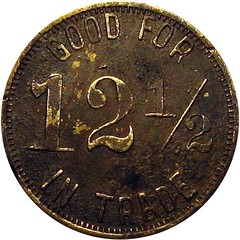
I asked Eric Schena for an opinion. He writes:
I actually read it as "You'll have to hop next door to jail" as one sentence with George Sharpe in the center. I would I believe it's a saloon token - 12 1/2¢ was a common denomination for saloon pieces.
To read the complete eBay lot description, see:
Cripple Creek
Colorado ? Good For Token George Sharpe Frog Next To Jail
(www.ebay.com/itm/Cripple-Creek-Colorado-Good-For-Token-George-Sharpe-Frog-Next-To-Jail-/221751296107)

2015 ROYAL BIRTH COINS
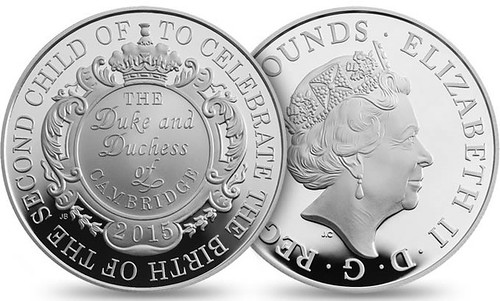
THE NATION CELEBRATES
As Their Royal Highnesses the Duke and Duchess of Cambridge welcome their second child, The Royal Mint strikes the perfect memento. Approved by Her Majesty The Queen and the proud parents, this UK £5 coin is the only official coin to mark the occasion of the new arrival.
There is such excitement as this new branch is added to the Royal Family tree, and it is only fitting that, as His Royal Highness Prince George becomes a big brother, we capture the moment for the nation just as we did for his birth.
- The only official coin to mark the Royal birth
- Reverse design by esteemed coinage artist John Bergdahl
- Free UK delivery with online orders over £45
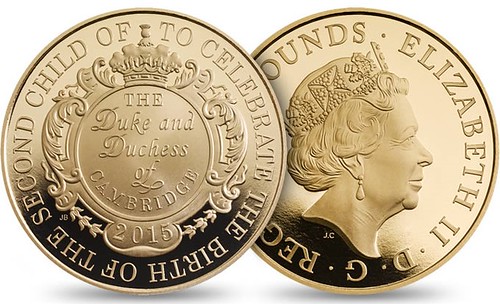
For more information, or to order, see:
The Royal Birth 2015 United Kingdom
£5 Silver Proof Coin (www.royalmint.com/shop/The_Royal_Birth_2015_United_Kingdom
_5_pound_Silver_Proof_Coin)
The Royal Birth 2015 United Kingdom £5
Gold Proof Coin (www.royalmint.com/shop/The_Royal_Birth_2015_United_Kingdom
_5_pound_Gold_Proof_Coin)
COIN DESIGNER PERCY METCALFE
 Percy Metcalfe was born on January 14, 1895 in Wakefield, West Yorkshire. At the age of 15 he won a
scholarship to the Leeds School of Art and from there he attended the Royal College of Art in London. With the outbreak of war in 1914, he
volunteered for military service and served in the Royal Artillery, however, a major injury to his leg meant he found it increasingly
difficult to stand for any length of time—a problem for a sculptor. Following the end of the war, he resumed his studies. On September 3,
1920 he married fellow student and sculptor—Eviline Smith and they went on to have two daughters.
Percy Metcalfe was born on January 14, 1895 in Wakefield, West Yorkshire. At the age of 15 he won a
scholarship to the Leeds School of Art and from there he attended the Royal College of Art in London. With the outbreak of war in 1914, he
volunteered for military service and served in the Royal Artillery, however, a major injury to his leg meant he found it increasingly
difficult to stand for any length of time—a problem for a sculptor. Following the end of the war, he resumed his studies. On September 3,
1920 he married fellow student and sculptor—Eviline Smith and they went on to have two daughters.
He first exhibited as a sculptor at the Royal Academy in 1921 but by 1922 he was turning his talents and skills in sculpture to medallic art and later to the design of coins. It was his work in designing the official exhibitors’ medals and the Royal Mint commemorative medal as well as a number of unofficial or privately authorised medals for the British Empire Exhibition at Wembley in 1924 that brought him to the attention of the Secretary of the English School in Rome who recommended his inclusion in the list of artists invited to submit designs for Ireland’s new coinage.
This young, relatively unknown medallist competed against some of the greatest names in early 20th century sculpture. His Irish designs were internationally acclaimed and prompted further commissions.
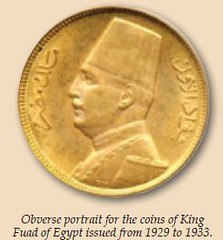
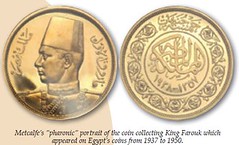
The first of these occurred a year later with a portrait of King Fuad of Egypt for the obverse of his coins. The commission was also in part probably prompted by a medal that Metcalfe had produced to mark the King’s visit to London in 1927. The portrait, as with all Metcalfe’s work, was made up of simple lines enabling a modern stylised coinage to be produced. As a medallist, Metcalfe had developed the skills to depict images in low relief—an absolute requirement for designs on coins. Metcalfe’s simple designs represented a major break from the more traditional, fussy and often overcrowded designs of other sculptors and engravers.
The portrait of Fuad shows the King in profile, looking left, with a fez and in military uniform. Metcalfe’s trademark initials “PM” are found left of the King’s epaulette. The design featured on Egypt’s coins from 1929 to 1933. In 1937, Metcalfe was chosen to design the portrait of the new Egyptian King, the coin-collecting Farouk. Metcalfe’s portrayal of the young king is almost “pharonic” in its treatment with the King’s chest and shoulder facing forwards with braided lanyards and orders of chivalry and the King’s head in profile looking sharp left. Metcalfe’s initials are again found at the base of the design. Metcalfe was also responsible for the design of the Arabic script that accompanied the portraits. His portrait of Farouk appeared on Egypt’s coins from 1937 through to 1950 and is probably the most striking of all his portraits for its simplicity but also for its presence.
The late 1920s also saw Metcalfe produce the more softer and less stylised portrait of the eight-year-old boy king, Michael I of Romania, which was to appear on his 5 lei and 10 lei coins issued in 1930—the last year of his fi rst reign as King of Romania (1927– 30). He was to reign again as King from 1940 until deposed by the post-war communist regime in 1947.
To read the complete issue, see:
Coin News May 2015
(digital.tokenpublishing.com/?pdfissueid={E7F96397-AFF8-4277-B54D-1D325F7E872D})
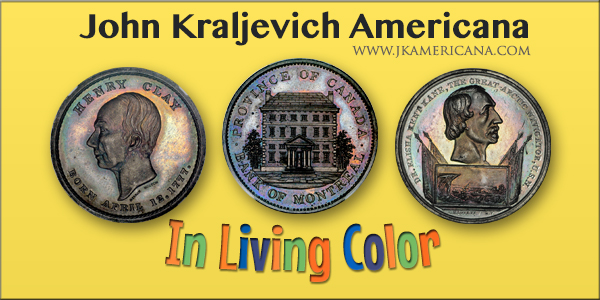
WILLCOX, AZ CENTENNIAL MEDAL ISSUED
Jeff Starck of Coin World writes:
A local newspaper reports about a centennial medal just issued for Willcox, Arizona. Thoughtfully, organizers held a design contest among students. Things like this are great ways to get younger people thinking about the hobby in an approachable, fun way.
The first Commemorative Coin commissioned by the City of Willcox recognizes the city’s 100 years of incorporation, 1915 to 2015. The coin is available for $5 at the Friendly Book Store, Chiricahua Regional Museum and at City Hall (the Historic Depot).
The design on the back of the coin represents agriculture, ranching and railroads and was designed by Kaycee Forsyth, who won a contest between eight designs submitted by students of Karina Stanger’s Art Class.
To read the complete article, see:
Willcox's first Commemorative Coin on
sale (www.willcoxrangenews.com/news/article_fc243c24-ee90-11e4-b01f-3ffd1762f16d.html)
FRESNO FIREFIGHTER FUNDRAISING COIN
In a similar topic, Jeff Starck of Coin World writes:
I’m sure there are legion of examples of numismatic items being used as fundraisers for non-profit causes, and here is another. A foundation has created a medal to raise money for a Fresno (Calif.) firefighter who fell through a roof and was injured/burned.
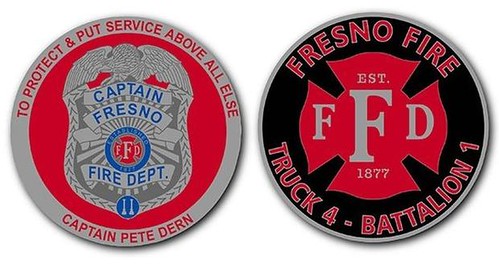
The Los Angeles Fire Department has created a coin as a benefit for the family of injured Fresno firefighter Pete Dern, who was critically burned while battling a home fire in March.
The collectible coin can be purchased for $25 through the Fire Family Foundation, with $20 of each coin going toward expenses for Dern’s family ($3 pays for shipping and $2 goes to the foundation).
Dern, a Fire Department captain, was hurt March 25 when he fell through the roof of a burning garage. He sustained second- and third-degree burns on 65% of his body.
To read the complete article, see:
Collectible coin made to help family of
injured Fresno firefighter Pete Dern (www.fresnobee.com/2015/04/28/4499239_collectible-coin-made-to-help.html?rh=1)

Archives International Auctions, Part XXIV
U.S. and Worldwide Banknotes and Scripophily
Highlights include:
- Lot 168 Continental Currency April 11, 1778 $8 XF to AU, Crisp.
- Lot 399 Standard Consolidated Mining Co. 1881 Proof Stock Certificate with Coin Vignette.
- Lot 177 Government of Texas, 1838 Third Issue
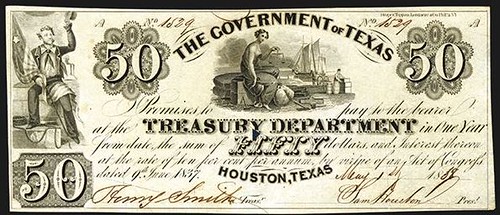
1580 Lemoine Avenue, Suite #7
Fort Lee, NJ 07024
Phone: 201-944-4800
Email: info@archivesinternational.com
WWW.ARCHIVESINTERNATIONAL.COM
NGC OFFERING ACCESS TO COINARCHIVES DATABASE
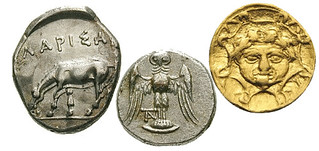 Internet resources have significantly leveled the playing field for the basic identification of coins,
yet it has done little to impact the nature of top-level expertise. Even today, the only way to learn the most advanced aspects of ancient
coinage is to physically handle and study tens of thousands of coins. Unfortunately, no amount of web-surfing can close that gap.
Internet resources have significantly leveled the playing field for the basic identification of coins,
yet it has done little to impact the nature of top-level expertise. Even today, the only way to learn the most advanced aspects of ancient
coinage is to physically handle and study tens of thousands of coins. Unfortunately, no amount of web-surfing can close that gap.
Identifying a ‘mystery ancient’ in the pre-Internet age was a daunting task. Short of asking someone who knew, there was no way around it: an excellent ancient coin library was necessary. Today, that same work often can be performed via the Internet by a relative novice, without the aid of a single book.
It is only the most advanced aspects of research and identification that still require a large, specialized library. At NGC, for example, we could not conduct our work without our substantial library. The same may be said for the top-level auction houses and dealers, who use their specialized references on a daily basis.
The best tool for those interested in researching ancient coins is CoinArchives, a comprehensive database of most every ancient coin sold at public auction in Europe and the United States for more than the last decade. Not only is it useful for researching values and making comparative judgments of quality, but it is also incredibly helpful for identification – even if you’ve never seen the coin before, and don’t have a clue where to start.
NGC is proud to have forged a relationship with A. J. Gatlin, founder of CoinArchives, which allows us to offer premium access to his database through our website. By going through NGC’s portal (as described above), visitors will have access to a larger and more varied selection of auction records.
Those who want access to the full database, which includes auctions going back to 2002, must take out a subscription to CoinArchives Pro, a service introduced in the summer of 2009. Details of how to subscribe are available on the CoinArchives website.
Any advanced collector or dealer will recognize that a CoinArchives Pro subscription is money well spent, for the amount saved (or made) even on a single coin due to a better-informed decision could greatly exceed the cost of an annual subscription.
To read the complete article, see:
NGC Ancients:
CoinArchives — Premium Research Tool for Ancient Coins
(www.coinweek.com/education/coin-grading/ngc/ngc-ancients-coinarchives-premium-research-tool-ancient-coins/)
PAPAL BENEMERENTI MEDAL STOLEN
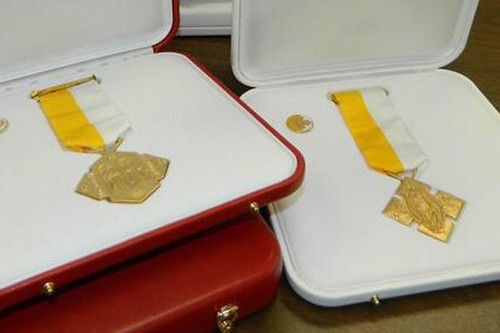
A rare medal awarded to members of the clergy by the Pope has been stolen from a man’s home in the Black Country.
A Benemerenti medal - an honour awarded for service to the Catholic Church - was taken from the property in Clarence Street, Upper Gornal, on the afternoon of April 17.
Police have circulated images of the medal to local second-hand shops to alert staff in case the item is offered for sale.
A watch was also stolen in the burglary.
Anyone offered the items should call police on 101 or alternatively information can be given anonymously to Crimestoppers on 0800 555 111.
To read the complete article, see:
Burglar snatches Papal medal in
Gornal house raid (www.birminghammail.co.uk/news/midlands-news/burglar-snatches-papal-medal-gornal-9128419)
To read the earlier E-Sylum articles, see:
THE PAPAL BENEMERENTI MEDAL (www.coinbooks.org/esylum_v11n19a17.html)
AUSTRALIAN WILDFIRE HERO RECEIVE PAPAL GOLD MEDAL
(www.coinbooks.org/esylum_v17n44a22.html)
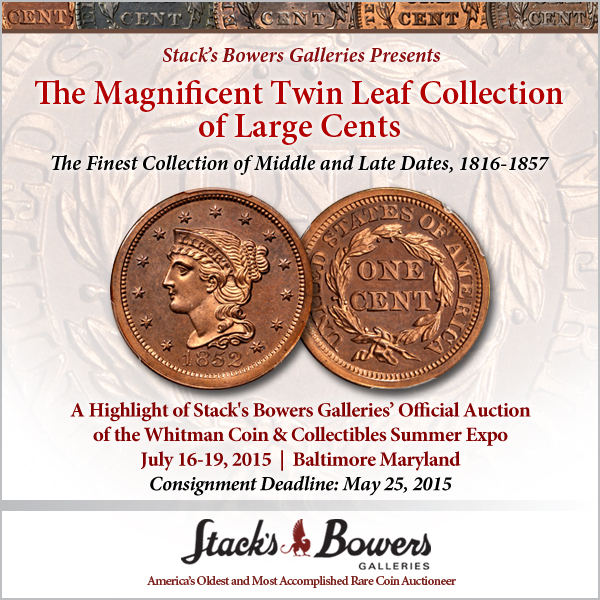
AN 1830 BOOK TYPESETTING ERROR
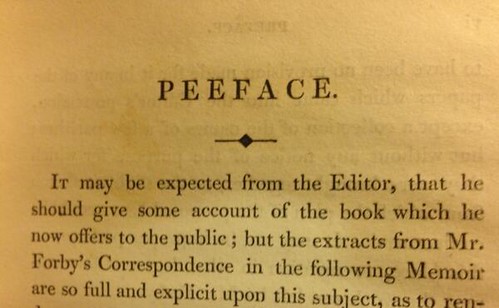
To read the complete article and comments, see:
Amazing typo from a book printed in 1830 (http://imgur.com/1Ol7FoQ)
To read the complete book, see:
(http://books.google.com/books?id=4tJUAAAAcAAJ)
FEATURED WEB SITE: THE MENORAH COIN PROJECT
This week's Featured Web Site is the Israel Numismatic Society's Menorah Coin Project, suggested by Arthur Shippee. Thanks!The world's #1 databank on Biblical-Judaean coins. Founded by JP Fontanille. 13,000 Judaean coins classified die per die - Online since 2002 - Constantly updated.

www.menorahcoinproject.org

